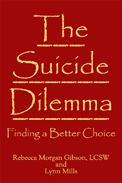
|
|
||
|---|---|---|---|
The Suicide Dilemma: Finding a Better Choice by Rebecca Morgan Gibson, LCSW and Lynn Mills Cosworth Publishing "You don’t have to be a mental health professional to recognize that someone is suicidal. If you respond and reach out in a caring and intelligent manner, the person may be saved."
A down-to-earth reader regarding suicide, the book covers significant information that the lay public needs to understand not only to be knowledgeable about the subject but to be an ally for those who suffer, including the suffering of one’s self and one’s own suicidal ideation. Topics include preventing suicide, losses, the myths and truths regarding suicide, symptoms of depression, talking to a suicidal person, treatment and recovery, and seven stories of people who have been suicidal. It ends with a discussion of the main points regarding suicide and how to survive when someone you love commits suicide. The book also offers research regarding this issue. In this concise yet thorough book, the authors of this compassionately written work treat this difficult subject in a straight-forward manner that takes the reader through the various topics necessary to help themselves or others who are struggling with depression and suicidal thoughts. The utilization of stories throughout the book offers a direct insight into the problem while allowing the reader to connect emotionally to the topic and to learn what others have learned from their suicide attempts. Especially valuable is the information on what to say and not say to a suicidal person, the myths of suicide, signs and stages of suicidality and lethality, and treatment options. There is also a helpful listing of resources. This book is an excellent examination of suicide and is recommended not only for the loved ones but for the suicidal person as well. It could also be helpful for mental health professionals (especially new professionals) as a guideline to help with clients, as well as a reading assignment for some clients. RECOMMENDED by the US Review
|
|||

